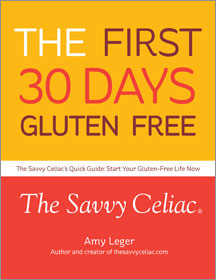This week I did it. I broke into my brand new bag of sorghum flour. That may not sound very exciting to some of you. But for a gluten-free baker (and I’m using that term VERY loosely), trying different flours is important. As I understand it, finding the perfect mix of gluten-free flours can be the difference between a favorite bread and a flop.
This however is my first venture into ANYTHING beyond the basics of rice flour, potato and tapioca starches (well I’ve done sweet rice flour too). I have had sorghum flour in my freezer for about 3 months — as I wondered what to do with it. And right next to it, is my quinoa flour — still unopened, but purchased at the same time. My goal is to test these babies out a few times before Thanksgiving — and learn how these two magical flours can work for me and my gluten-free peeps.
Why use sorghum?
Here’s what I’ve learned about sorghum flour so far. According to Robert Landolphi’s Gluten Free Every Day Cookbook, sorghum flour is “a heavy flour ground from cereal grain…[it] resembles wheat flour and works very well in baked goods such as muffins and breads.” Landolphi also explains that sorghum is a whole grain flour and is higher in fiber and protein than other refined white flours. He says sorghum is one of his primary flours that is the most versatile in the kitchen.
According to Landolphi’s book, 1/4 cup of sorghum has fewer calories, three times the fiber and twice the protein than white rice flour. The nutritional value appears to be one of the main reasons why someone eating gluten-free may use this in cooking. Another reason that came up was just to have plain old variety.
My attempt at baking with sorghum
So Tuesday I made a bold attempt to make a gluten-free cinnamon bread in my bread machine. I cut my regular flour by nearly a third, and added the rest as sorghum flour. I put in the rest of my ingredients plus my “mix ins” of cinnamon and sugar. I was excited to see and taste the finished product, but while it was baking I started to smell something burning!!! Yes, for the second time in less than a year, my bread machine overflowed! Ugh. The entire house stunk!!
I originally deduced that overflowage would happen when I used large eggs — that really were on the extra large side. I had been cutting my three eggs down to two whole eggs and one egg white. I did that with yesterday’s recipe too, but it overflowed like crazy. I’m sort of wondering if the sorghum played a role? I’m not sure that I’ll ever know unless I do the same thing again, but without the final egg whites.
Sorghum flour baking tips
If you are experimenting like I am, there are a few notes you should consider to try and make your dish a success. eHow.com describes why sorghum can be tricky:
“When baking with sorghum flour as a direct substitute for all-purpose flour, you must add other ingredients to compensate for dryness. Foods baked with sorghum flour are also extremely likely to crumble.” -eHow.com
Corn starch seems to help bring the best out in sorghum. According to eHow.com you should add 1/2 TBSP of corn starch with each cup of sorghum flour — unless you’re baking bread, then you increase the corn starch to 1 TBSP. Other options: add a little oil if the recipe seems dry or add a little egg or egg white if it is too crumbly, says Twin Valley Mills, a producer of sorghum flour.
Tired of spending gobs of money on flours? Practicallyedible.com recommends getting sorghum flour at a lower prices by going to an Indian food market and look for sorghum flour under a different name: jowar or juwar.
One final tip, sorghum does have a shelf life…so you need to make sure you don’t old rancid flour. Twin Valley Mills says,
“…at room temperature it should stay fresh for several months. However, if refrigerated or frozen the shelf life can be extended and freshness preserved.”
Landolphi is a little more specific. “Store in an airtight container in a cool, dry place for up to 1 month, refrigerate for up to 3 months or freeze for up to 6 months.”
Now I need to keep trying sorghum…But my next big task is to open up the bag of quinoa flour.
Tags: baking, experiment, flour, gluten-free, sorghum, whole grain



November 18th, 2009 at 3:46 pm
Some of my best GF baking has been with sorghum flour. I just swap sorghum for wheat flour 1:1 in regular recipes and it works great. Pie crusts, muffins, pancakes, waffles, etc. taste great, a slightly grainier texture but not overwhelming. Sorghum flour can be bought very cheap at cultural specialty markets – especially Indian markets. Bob’s red mill is much more expensive and my results with Indian sorghum flour have been much more successful.
December 1st, 2010 at 10:54 am
I am just starting to venture into the world of wheat free baking and thought i would take it easy on myself for my first attempt. so i bought a bobs red mill wheat free flour mixture that has two types of bean flour as well as sorghum flour in it. To hold it all together i added some xanthum. The muffins i made were ok but had a slightly metallic or tin flavor to them. Have you ever experienced this or have any idea where that might come from. It is almost the same as when you eat canned tomatoes compared to fresh.
December 1st, 2010 at 12:14 pm
Erin, Congrats on your experimentation. I have not had the metallic taste of which you speak. I add sorghum to my daughter’s bread as well as make banana bread with it. But it is only a portion of the flour that’s used.
Maybe its another ingredient that’s giving you that flavor. This forum: http://forums.glutenfree.com/post77384.html is talking about Millet as giving a metallic flavor to something.
But another source (http://lincatz.tripod.com/recipes.html) says Bean flour could be it: “Bean flour: I don’t like bean flour, in spite of the fact that it’s more nutritious than plain starches. I have yet to find a bean flour that doesn’t have a harsh metallic taste when baked. It can be used in savoury baking, such as garlic bread, savoury muffins and anywhere that the metallic taste is masked with herbs and other flavours, but not in sweet baking where the metallic flavour overwhelms everything else. It also make cookies heavy and dense.”
I would keep experimenting with sorghum but maybe eliminate the bean flours and see what happens.
June 3rd, 2012 at 4:54 pm
Thanks for this! I’m hoping to use sorghum in a pancake recipe and your post has made me feel more comfy using it. :o)
September 11th, 2012 at 10:49 am
Im am looking for a great gluten free flour combination to make a pastry for samosas, Ive had to stop eating these over the last 5 years, I can eat 15 of them in one sitting so you can see Im missing then lots. I have tried mixed GF flours from supermarkets to no success. Could you suggest what could help.
December 31st, 2012 at 9:33 am
I have been cooking with Bobs Red Mill all purpose flour and also noticed a tin type metallic taste also, so I now have been using the sourghum flour which taste much better.
August 1st, 2013 at 6:52 pm
I’ve never used sorghum without mixing it with other “heavier” flours, so I wonder if they mask the taste. You talking about your bread maker overflowing reminds me of my first attempts at making GF bread, where it rose and rose. And rose some more. At first it was “I’m going to have a huge loaf, great!” the it was “Uh Oh” then “It’s going to overflow and be a huge mess.” But no worries, it collapsed in spectacular fashion. I mean.. down to one inch in the middle. Turns out yeast goes a little hyper with potato flour and it filled with air, then lets out a silent but violent one.
October 12th, 2014 at 1:15 pm
I use this flour to make flat breads. As an indian this was our traditional grain and what we digest easier than wheat but having never witnessed my traditional background only looked into it more due to wheat allergies. Its true this is much cheaper in an indian shop and alternatively called JUWAR or JUWHER it comes in kilo packs.
Rub 1 cup (250ml) flour with 50g butter and add enough boiling water (approx 155mls) slowly so as to form a rough ball. Next knead for 1 minute. Then put large frying pan or griddle on heat put a layer of oil when hot to make it non stick then take a small ball of dough about the size of a satsuma and role between two pieces of plastic or cling film so it is as thin as shortcrust pastry and about 6cm across. lift carefully and cook about 3 minutes on either side until it looks brown and not wet or dough coloured, now it is ready to eat, on its own or with asian food or with jam.
when really proficent try patting it out to shape on your hands, there maybe a youtube video on this? sorghum chappatis?